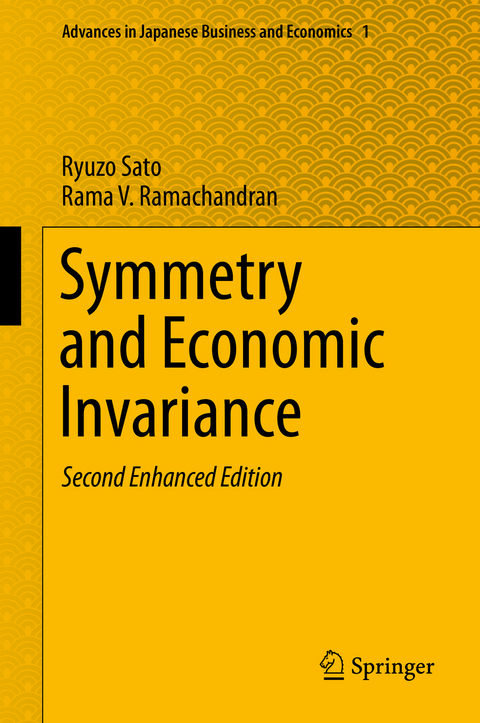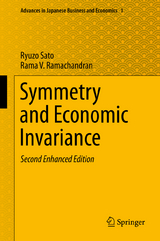Symmetry and Economic Invariance
Springer Verlag, Japan
978-4-431-54429-6 (ISBN)
Ryuzo Sato Ryuzo Sato is C.V. Starr Professor Emeritus of Economics at the Stern School of Business, New York University. He was director of the Center for Japan–U.S. Business and Economic Studies at the Stern School. Prior to becoming a Stern faculty member, he was a professor of economics at Brown University. Professor Sato also taught at Harvard University, The University of Tokyo, Kyoto University, and Bonn University. He was the founding chief editor of Japan and the World Economy, an international theory and policy journal. For more than 40 years, Professor Sato has divided his time between Japan and the USA, and he conducts research, gives lectures, and writes on the subject of Japan–US relations. Recent work includes Biased Technical Change and Economic Conservation Laws (Springer, 2006), Growth Theory and Technical Change: The Selected Essays of Ryuzo Sato, vol. 1 (Edward Elgar, 1996), Production, Stability and DynamicSymmetry: The Selected Essays of Ryuzo Sato, vol. 2 (Edward Elgar, 1999), and Theory of Technical Change and Economic Invariance: Application of Lie Groups (Academic Press, 1981; reprint, new version, Edward Elgar, 1999). Professor Sato also writes columns regularly for several Japanese newspapers. Professor Sato, who was a Fulbright Scholar, received his B.A. in economics and his Dr. Economics from Hitotsubashi University in Tokyo, and his Ph.D. in economics from Johns Hopkins University. His principal areas of research interest are mathematical economics and economic growth. Rama V.Ramachandran Rama V.Ramachandran received his master’s degree from Madras University, India, and his Ph.D. from Brown University in the U.S.A. He was a faculty member of the Department of Economics of Southern Methodist University and the Department of Economics of the Stern School of Business, New York University. He was associate director of the Center for Japan–U.S. Business and Economics at the Stern School. His research interests were in microeconomics and growth theory. After retirement, he has focused on economic pedagogy and authored an innovative introduction to microeconomics, Opportunities and Choices: Understanding Our Economic Decisions. (http://www.visualeconomicanalysis.info/index.html)
Part I Introduction
1 Introduction
1.1 GROUP THEORY AND CLASSIFICATION OF MATHEMATICAL STRUCTURE
1.2 LIE GROUPS AND INVARIANCE
1.3 ECONOMIC APPLICATIONS OF LIE GROUPS
2 Technical Progress and Economies of Scale: Concept of Holotheticity
2.1 A REFORMULATION OF THE PROBLEM
2.2 LIE GROUPS
2.3 HOLOTHETICITY
2.4 CONCLUSION
3 Holothetic Production Functions and Marginal Rate of Technical Substitution
3.1 TYPES OF TECHNICAL PROGRESS FUNCTIONS AND HOLOTHETICITY
3.2 MARGINAL RATE OF TRANSFORMATION AND EXTENDED TRANSFORMATION
3.3 HOLOTHETICITY AND LIE BRACKET
3.4 CONCLUSION
4 Utility and Demand
4.1 INTEGRABILITY CONDITIONS
4.2 CONCLUSION
5 Duality and Self Duality
5.1 DUALITY IN CONSUMER THEORY
5.2 SEPARABILITY AND ADDITIVITY
5.3 SELF-DUALITY IN DEMAND THEORY
5.4 A METHOD OF DERIVING SELF-DUAL DEMAND FUNCTIONS
5.5EMPIRICAL ESTIMATION OF SELF-DUAL DEMAND FUNCTIONS
5.6 IMPLICIT SELF-DUALITY OF PRODUCTION AND COST FUNCTIONS
5.7 CONCLUSION
6 The Theory of Index Numbers
6.1 STATISTICAL APPROACH
6.2 TEST APPROACH
6.3 ECONOMIC INDEX NUMBERS
6.4 DIVISIA INDEX
7 Dynamics and Conservation Laws
7.1 THE VARIATIONAL PROBLEM AND THE RAMSEY RULE
7.2 STEADY STATE AND THE GOLDEN RULES
7.3 THE HAMILTONIAN FORMULATION AND CONTROL THEORY
7.4 NOETHER THEOREM AND ITS IMPLICATIONS
7.5 CONSERVATION LAWS IN VON NEUMANN MODEL
7.6 MEASUREMENT OF NATIONAL INCOME AND INCOME-WEALTH RATIOS
7.7 CONCLUSION
Part II Recent Developments
8 The Invariance Principle and Income-Wealth Conservation Laws
8.1 INTRODUCTION
8.2 BRIEF SUMMARY OF THE LITERATURE
8.3 A MODEL WITH HETEROGENEOUS CAPITAL GOODS
8.4 NOETHER’S THEOREM (INVARIANCE PRINCIPLE
8.5 INCOME-WEALTH CONSERVATION LAWS
8.6 SPECIAL CASES
8.7 GENERALIZED INCOME/ WEALTH CONSERVATION LAWS
8.8 INCOME-CAPITAL (WEALTH) CONSERVATION LAW
IN THE VON NEUMANN MODEL
8.9 THE TOTAL VALUE CONSERVATION LAWOF THE FIRM
8.10 EMPIRICAL APPLICATIONS
8.11 SUMMARY
9 Conservation Laws in Continuous and Discrete Models---In memory of Professor Mineo Ikeda
9.1 INTRODUCTION
9.2 CONTINUOUS MODELS
9.3 DISCRETE MODELS (2012 VERSION) BY SHIGERU MAEDA
9.4 SUMMARY
10 Quantity or Quality: The Impact of Labour Saving Innovation on US and Japanese Growth Rates, 1960–2004
10.1 INTRODUCTION
10.2 A MODEL OF BIASED (LABOUR SAVING) TECHNICAL CHANGE
10.3 APPLICATIONS TO THE US AND JAPANESE DATA
10.4 CONCLUSION
11 A Survey on Recent Developments
11.1 Introduction
11.2 Extensions of the Income-Wealth Conservation Law
11.3 Externalities and Policy Interventions
11.4 Stochastic Income and Wealth Conservation Law
11.5 Warning
11.6 Conservation Laws and Helmholtz Conditions
11.7 Comparisons: Three Approaches
11.8 Hartwick Rule and Conservation Laws
11.9 More Abstract Applications of Group Theory to Economics and Finance
12 Appendix to Part II---Symmetry: An Overview of Geometric Methods in Economics
12.1 INTRODUCTION
12.2 TOOLBOX
12.3 HOLOTHETICITY: SYMMETRY OF THE ISOQUANT MAP
12.4 EXAMPLES OF CONSERVATION LAWS IN ECONOMICS
12.5 CONCLUSION
| Erscheint lt. Verlag | 19.12.2013 |
|---|---|
| Reihe/Serie | Advances in Japanese Business and Economics ; 1 |
| Zusatzinfo | 44 Illustrations, black and white; XII, 273 p. 44 illus. |
| Verlagsort | Tokyo |
| Sprache | englisch |
| Maße | 155 x 235 mm |
| Themenwelt | Geschichte ► Teilgebiete der Geschichte ► Wirtschaftsgeschichte |
| Mathematik / Informatik ► Mathematik ► Angewandte Mathematik | |
| Mathematik / Informatik ► Mathematik ► Finanz- / Wirtschaftsmathematik | |
| Wirtschaft ► Allgemeines / Lexika | |
| Wirtschaft ► Volkswirtschaftslehre | |
| Schlagworte | Economic equilibrium • economic models • Group-theoretic Analysis • Invarianz • Lie groups • ökonomische Modelle • Ungleichheit |
| ISBN-10 | 4-431-54429-1 / 4431544291 |
| ISBN-13 | 978-4-431-54429-6 / 9784431544296 |
| Zustand | Neuware |
| Informationen gemäß Produktsicherheitsverordnung (GPSR) | |
| Haben Sie eine Frage zum Produkt? |
aus dem Bereich




